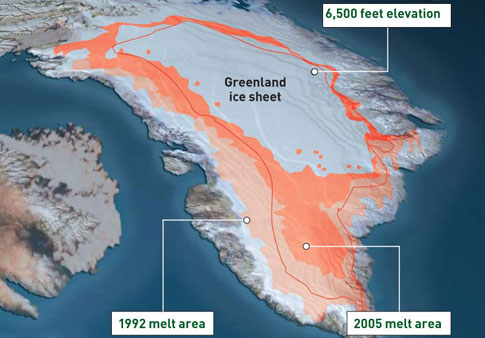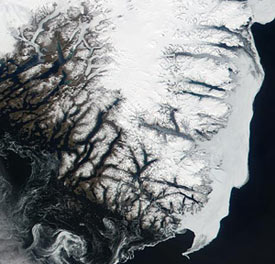|
|
 |
|
Update 2007. This is a report worth reading one and all! This appeared in Popular Science.. Here is a small extract! A glacier that accelerates with a warming atmosphere is within the realm of scien-tific expectation. But according to the conventional wisdom of glaciology, the massive ice sheets that cover most of Greenland and Antarctica should respond much more slowly to variations in temperature, with appreciable changes happening across hundreds and thousands of years. Yet Steffen's ground-based instruments and satellite data were showing that the ice under Swiss Camp was accelerating as temperatures rose, flowing at speeds of up to 20 inches a day as ice melted in places where it had once stood solid. Seismographs picked up increasingly frequent ice quakes, as the 5,000-foot-thick ice cap lurched toward the sea. By 2006, Greenland's ice sheet was shedding some 150 gigatons per year—a mass surpassing all the ice in the Alps. "We realized that something was going wrong," Steffen says. "Greenland was coming apart."
Dwindling Snow Cone Konrad Steffen's work has shown that the extent of snowmelt in Greenland increased drastically between 1992 and 2005. Some frozen areas of Greenland have always melted each summer, but as global temperatures rise, Steffen's instruments have detected melting at higher elevations and latitudes. Instead of liquefying merely around the southern and eastern edges of Greenland, the ice pack is melting farther north and farther inland than before. Some scientists believe that large amounts of Greenland's melted freshwater could dilute the salinated water of the Gulf Stream, disrupting the movement of the North Atlantic waters that regulate weather in Europe. We have included other articles connected to this situation re CO2 and methane see methane subject for more and the possible sudden intake of CO2 that could happen through the increased release of methane into the atmosphere. Update October 2006. Report courtesy of NASA.. and Physorg.com
For the first time NASA scientists have analyzed data from direct, detailed satellite measurements to show that ice losses now far surpass ice gains in the shrinking Greenland ice sheet. Using a novel technique that reveals regional changes in the weight of the massive ice sheet across the entire continent, scientists at NASA's Goddard Space Flight Center, Greenbelt, Md., report that Greenland's low coastal regions lost 155 gigatons (41 cubic miles) of ice per year between 2003 and 2005 from excess melting and icebergs, while the high-elevation interior gained 54 gigatons (14 cubic miles) annually from excess snowfall. The study appears in Science Express, the advance edition of Science, on Oct. 19. "With this new analysis we observe dramatic ice mass losses concentrated in the low-elevation coastal regions, with nearly half of the loss coming from southeast Greenland," said lead author Scott Luthcke of NASA Goddard's Planetary Geodynamics Laboratory. "In the 1990's the ice was very close to balance with gains at about the same level as losses. That situation has now changed significantly, with an annual net loss of ice equal to nearly six years of average water flow from the Colorado River."
Back in 2004 this report came out in Agence France-Presse copyright 2004 April 7th 2004. PARIS (AFP) - Greenhouse gas pollution is so bad that on current trends, Greenland's icesheet may start to melt by the end of this century, a scenario that eventually will drown coastlines around the world, a study warns. AFP/HO/File Photo Missed Tech Tuesday? Wal-Mart's doing it, and soon tech could track your every move. Here's how to protect yourself from RFID. Destruction of the icesheet -- second in size to Antarctica's -- would drive up sea levels by seven metres (22.75 feet) over a thousand years or more, and the process may well be irreversible, it says. Indeed, tentative evidence suggests the icesheet has already to started to melt, lead author Jonathan Gregory told AFP. "It's quite possible that Greenland is already making a slight contribution to global sea levels," said Gregory, a meteorologist at the University of Reading, southern England. Published on Thursday in the British weekly science journal Nature, the research uses a sophisticated computer model to forecast what happens to the icesheet at different levels of carbon dioxide (CO2) emissions -- the gas spewed out by the burning of fossil fuels that drives global warming. Before industrialisation, the atmosphere contained 280 parts per million (ppm) of CO2. At present it stands at 370 ppm. The computer model ran through various scenarios, in which CO2 is stabilised at 450, 550, 650, 750 and 1,000ppm. And it factored in the latest data that points to how parts of the northern hemisphere are particularly vulnerable to global warming. The risk factor here is a phenomenon called albedo: the ability of a landscape to reflect sunlight. Ice and snow reflect sunlight, and thus heat. The more exposed a landscape is, the more heat it absorbs; this in turn melts more of the ice, and so the warming process continues, becoming a vicious circle. In most of the combinations that were crunched through the computer model, Greenland warmed by about 3.0 degrees Celsius (5.4 Fahrenheit) by 2100 compared with 1990 levels, a temperature at which the icesheet starts to contract, for melting will exceed snowfall. In many cases, the warming is predicted to exceed eight decrees Celsius (11.2 Fahrenheit) by the year 2350, a temperature virtually considered a doomsday by the UN's top scientific body on global warming, the Intergovernmental Panel on Climate Change (IPCC). The study points out that the lowest CO2 concentration used in the model, of 450ppm, is almost certain to be exceeded by 2050 alone -- and that carbon dioxide is only one of six important greenhouse gases. "We conclude that the Greenland icesheet is likely to be eliminated by anthropogenic (man-made) climate change unless much more substantial emission reductions are made than those envisaged by the IPCC," the authors say. "This would mean a global average sea-level rise of seven metres during the next 1,000 years or more." Even if CO2 levels and global temperatures return to pre-industrial levels, the icesheet may never be regenerated, because Greenland's landmass would have warmed because of the loss of albedo. The only international agreement on cutting greenhouse gases is the UN's Kyoto Protocol, which requires industrial countries to make a small cut in global emissions by a timeframe of 2008-12. But the pact is in limbo. It still needs ratification by Russia to take effect and in any case has been abandoned by the United States, the world's biggest CO2 polluter Now this one in 2005. Report from Nasa.20/5/2005 Nasa scientists have warned that global warming is affecting Greenland's entire ice sheet as well as its glaciers. Greenland's fate is seen as crucial to the future of the world's sea levels.
|
|
(c) Copyright 1993-2008 Publishing |
| [Home] [Main index] [Environment] [Greenland Icesheet] |

